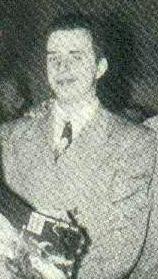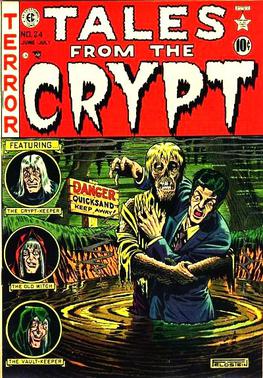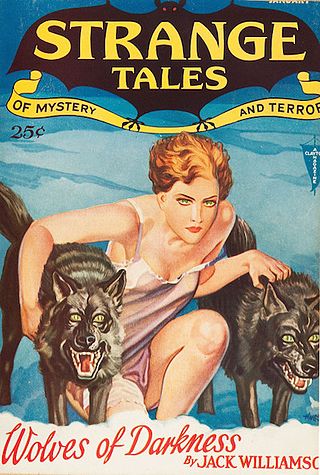 |
| Speculative fiction |
|---|
| |
A horror fiction magazine is a magazine that publishes primarily horror fiction with the main purpose of frightening the reader. Horror magazines can be in print, on the internet, or both.
 |
| Speculative fiction |
|---|
| |
A horror fiction magazine is a magazine that publishes primarily horror fiction with the main purpose of frightening the reader. Horror magazines can be in print, on the internet, or both.

Robert Albert Bloch was an American fiction writer, primarily of crime, psychological horror and fantasy, much of which has been dramatized for radio, cinema and television. He also wrote a relatively small amount of science fiction. His writing career lasted 60 years, including more than 30 years in television and film. He began his professional writing career immediately after graduation from high school, aged 17. Best known as the writer of Psycho (1959), the basis for the film of the same name by Alfred Hitchcock, Bloch wrote hundreds of short stories and over 30 novels. He was a protégé of H. P. Lovecraft, who was the first to seriously encourage his talent. However, while he started emulating Lovecraft and his brand of cosmic horror, he later specialized in crime and horror stories working with a more psychological approach.

Ramsey Campbell is an English horror fiction writer, editor and critic who has been writing for well over fifty years. He is the author of over 30 novels and hundreds of short stories, many of them winners of literary awards. Three of his novels have been adapted into films.
Arkham House was an American publishing house specializing in weird fiction. It was founded in Sauk City, Wisconsin, in 1939 by August Derleth and Donald Wandrei to publish hardcover collections of H. P. Lovecraft's best works, which had previously been published only in pulp magazines. The company's name is derived from Lovecraft's fictional New England city, Arkham, Massachusetts. Arkham House editions are noted for the quality of their printing and binding. The printer's mark for Arkham House was designed by Frank Utpatel.

Carl Richard Jacobi was an American journalist and writer. He wrote short stories in the horror and fantasy genres for the pulp magazine market, appearing in such pulps of the bizarre and uncanny as Weird Tales, Ghost Stories, Startling Stories, Thrilling Wonder Stories and Strange Stories. He also wrote stories crime and adventure which appeared in such pulps as Thrilling Adventures, Complete Stories, Top-Notch, Short Stories, The Skipper, Doc Savage and Dime Adventures Magazine. Jacobi also produced some science fiction, mainly space opera, published in such magazines as Planet Stories. He was one of the last surviving pulp-fictioneers to have contributed to the legendary American horror magazine Weird Tales during its "glory days". His stories have been translated into French, Swedish, Danish and Dutch.

Frank Belknap Long Jr. was an American writer of horror fiction, fantasy, science fiction, poetry, gothic romance, comic books, and non-fiction. Though his writing career spanned seven decades, he is best known for his horror and science fiction short stories, including contributions to the Cthulhu Mythos alongside his friend, H. P. Lovecraft. During his life, Long received the World Fantasy Award for Life Achievement, the Bram Stoker Award for Lifetime Achievement, and the First Fandom Hall of Fame Award (1977).

A science fiction magazine is a publication that offers primarily science fiction, either in a hard-copy periodical format or on the Internet. Science fiction magazines traditionally featured speculative fiction in short story, novelette, novella or novel form, a format that continues into the present day. Many also contain editorials, book reviews or articles, and some also include stories in the fantasy and horror genres.

A fantasy fiction magazine, or fantasy magazine, is a magazine which publishes primarily fantasy fiction. Not generally included in the category are magazines for children with stories about such characters as Santa Claus. Also not included are adult magazines about sexual fantasy. Many fantasy magazines, in addition to fiction, have other features such as art, cartoons, reviews, or letters from readers. Some fantasy magazines also publish science fiction and horror fiction, so there is not always a clear distinction between a fantasy magazine and a science fiction magazine. For example, Fantastic magazine published almost exclusively science fiction for much of its run.

Donald Albert Wandrei was an American science fiction, fantasy and weird fiction writer, poet and editor. He was the older brother of science fiction writer and artist Howard Wandrei. He had fourteen stories in Weird Tales, another sixteen in Astounding Stories, plus a few in other magazines including Esquire. Wandrei was the co-founder of the prestigious fantasy/horror publishing house Arkham House.
Joseph Payne Brennan was an American writer of fantasy and horror fiction, and also a poet. Of Irish ancestry, he was born in Bridgeport, Connecticut and he lived most of his life in New Haven, Connecticut, and worked as an Acquisitions Assistant at the Sterling Memorial Library of Yale University for over 40 years. Brennan published several hundred short stories, two novellas and reputedly thousands of poems. His stories appeared in over 200 anthologies and have been translated into German, French, Dutch, Italian and Spanish. He was an early bibliographer of the work of H. P. Lovecraft.
Speculative poetry is a genre of poetry that focusses on fantastic, science fictional and mythological themes. It is also known as science fiction poetry or fantastic poetry. It is distinguished from other poetic genres by being categorized by its subject matter, rather than by the poetry's form. Suzette Haden Elgin defined the genre as "about a reality that is in some way different from the existing reality."

Robert Augustine Ward "Doc" Lowndes was an American science fiction author, editor and fan. He was known best as the editor of Future Science Fiction, Science Fiction, and Science Fiction Quarterly, among many other crime-fiction, western, sports-fiction, and other pulp and digest sized magazines for Columbia Publications. Among the most famous writers he was first to publish at Columbia was mystery writer Edward D. Hoch, who in turn would contribute to Lowndes's fiction magazines as long as he was editing them. Lowndes was a principal member of the Futurians. His first story, "The Outpost at Altark" for Super Science in 1940, was written in collaboration with fellow Futurian Donald A. Wollheim, uncredited.
Rocco A. "Rocke" Mastroserio was an American comic book artist best known as a penciler and inker for Charlton Comics. He sometimes signed his work "Rocke M.," "RM," "Rocke," or "RAM."

The Australian Horror and Fantasy Magazine (1984–86) was edited by (Michael) Barry Radburn and Stephen Studach. The first Australian semi-professional publication devoted to the weird and the macabre, it was published by Radburn's imprint Dark Press. It ran six issues; Issues 1, 2 and 3 all appeared in 1984, issue 4 in 1985 and the last, issue being a double issue (5/6) which was co-edited by Carol Dobson and Nerida Radburn, 1986.

The Outsider and Others is a collection of stories by American writer H. P. Lovecraft. It was released in 1939 and was the first book published by Arkham House. 1,268 copies were printed. It went out of print early in 1944 and has never been reprinted.

Henry St. Clair Whitehead was an American Episcopal minister and author of horror, some non fiction and fantasy fiction.

The Dark Man and Others is a posthumously-published anthology of fifteen short stories by American author Robert E. Howard, named after his short story "The Dark Man", and covering the genres of adventure fiction, horror, historical fiction, fantasy, sword and sorcery, weird fiction and the weird West. It was first published in 1963 by Arkham House, and was edited by August Derleth. Eleven of the stories had previously been published in the pulp magazine Weird Tales, and one each in Argosy, Oriental Stories and Strange Tales. It was reprinted in 1971 as a paperback by Lancer.
Mary Elizabeth Counselman was an American writer of short stories and poetry.
David F. Case was an American writer of short stories and novels.

Horror comics are comic books, graphic novels, black-and-white comics magazines, and manga focusing on horror fiction. In the US market, horror comic books reached a peak in the late 1940s through the mid-1950s, when concern over content and the imposition of the self-censorship Comics Code Authority contributed to the demise of many titles and the toning down of others. Black-and-white horror-comics magazines, which did not fall under the Code, flourished from the mid-1960s through the early 1980s from a variety of publishers. Mainstream American color comic books experienced a horror resurgence in the 1970s, following a loosening of the Code. While the genre has had greater and lesser periods of popularity, it occupies a firm niche in comics as of the 2010s.

Strange Tales was an American pulp magazine first published from 1931 to 1933 by Clayton Publications. It specialized in fantasy and weird fiction, and was a significant competitor to Weird Tales, the leading magazine in the field. Its published stories include "Wolves of Darkness" by Jack Williamson, as well as work by Robert E. Howard and Clark Ashton Smith. The magazine ceased publication when Clayton entered bankruptcy. It was temporarily revived by Wildside Press, which published three issues edited by Robert M. Price from 2003 to 2007.